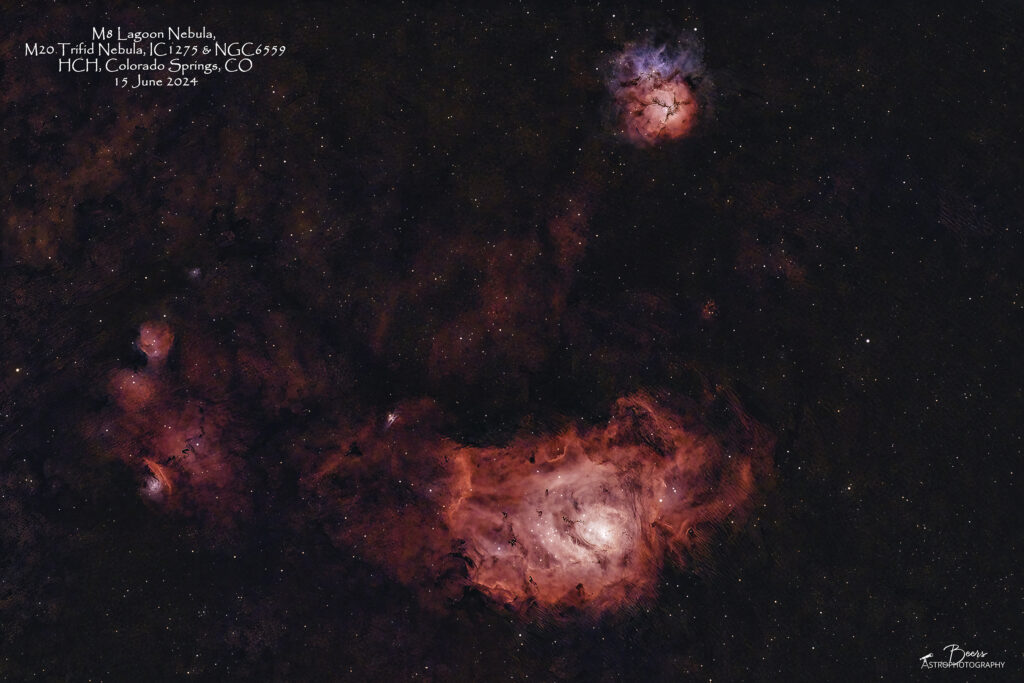Since returning from my March 2024 Atacama Desert imaging trip, I’ve been struggling with hardware and software issues. The GPS card in my Rainbow Astro RST-135 mount seems to have been the final malfunctioning piece of hardware to be identified, diagnosed, and fixed in early June. Mid-June provided the first clear skies to give the full set-up a test run. …and it seems apropos that I would chose to image M8 Lagoon Nebula!

With the final piece of equipment fixed…let’s take it for a test run
Since returning from my March 2024 Atacama Desert imaging trip, I’ve been struggling with many and varied hardware and software issues with the equipment (the Southern Cross) used during that trip. Working with Tolga, from Tolga Astro (the BEST customer service on the planet!) we identified and diagnosed the GPS card in my Rainbow Astro RST-135 mount as the final malfunctioning piece of hardware. Tolga worked with the Rainbow Astro technician who provided him with a replacement GPS card, I shipped the hand controller to Tolga, and he replaced the malfunctioning card and returned the hand controller to me in early June.
Mid-June provided the first clear skies (YES! Mother Nature has had her evil say in this process too!) to give the fully functioning set-up a test run. When I started my June target planning, I decided to revisit the M8 Lagoon Nebula, which I hadn’t imaged since my early days (actually on my first successful night of DSO imaging at Rocky Reservoir, Colorado when my laptop (running Astrophotography Tool (APT)) – Big Bertha – Canon EOS Ra came together for the first time). My renewed interest in imaging M8 came from my conversation/ experience with the Chile AP tour guide, who was going to have us travel to Chile in August to image M8 and M16. That conversation caused me to back out of his workshop and plan my own when I had visibility of targets I couldn’t see from the front patio!
Although there were several warnings from SGPro throughout the imaging session (that the autoguider was struggling and recovery mode was invoked several times) things went well. I was surprised that the meridian flip executed on its own at some point before the point where I’d set it to occur (when the mount is 20 minutes past the median point). I always set an alarm and go out to do the meridian flip “by hand.” When I got outside, SGPro said it was about 1:40 minutes before the flip and there was about 45 seconds left in the exposure. So I selected “pause sequence” but forgot to select “run end of sequence actions.” When the sequence paused, I looked up at the mount and realized that it was already on the east side of the pier (i.e., it had already executed the meridian flip). I resumed the sequence and off it went for the rest of the night!
Even though it was the quarter moon (when I normally would have used the LeXtreme filter – but I wanted to capture the blue portions of the M20 Trifid Nebula that were also within the frame), the LPro filter produced a good result – albeit not as good as my nascent APer’s image captured in the dark skies of Rocky Reservoir in July 2021. This is definitely on my imaging list for dark skies (hopefully coming up over the 4th of July weekend)!
The gallery image is: https://beersastrophotography.com/gallery/m8-lagoon-nebula-m20-trifid-nebula/ with target fun facts and the information about the data capture.
